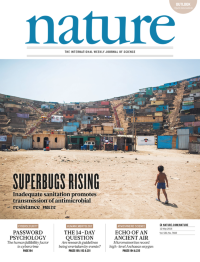Volume 533
-
No. 7604 26 May 2016
Meerkats are small social carnivores, and within each group a single dominant breeding pair monopolizes reproduction, while their offspring are reared by all group members. Competition for the breeding role is intense and the place of an individual in the social hierarchy depends on its size and weight. Elise Huchard et al. studied a natural population of wild Kalahari meerkats and show that they are continually sizing-up one another to ensure that they are not overtaken in size � and therefore social status � by younger upstarts. Once a meerkat gets to the top of the pile, it puts on a spurt of growth to ensure that it remains bigger and heavier than its largest rival. The authors suggest that similar responses to the risk of competition might occur in other social mammals such as domestic animals and primates. Cover: Nathan Thavarajah.
-
No. 7603 19 May 2016
A manually created low-poly representation of the bacteriophage T4 baseplate structure in its pre-host cell attachment state. Bacteriophage T4 uses its contractile tail to inject its genome into a bacterial host cell. Central to this process is the baseplate, at the end of the tail. In a tour-de-force of structural biology, Nicholas Taylor, Petr Leiman and colleagues use cryo-electron microscopy to create an atomic model of the T4 baseplate in its pre- and post-host attachment conformations, providing the first molecular view of the sequence of events that leads to the transition between these two states. The baseplatetail tube complex comprises 145 polypeptide chains of 15 different proteins, and the structures reveal how the baseplate couples host recognition to sheath contraction. The structure and organization of all core baseplate components are conserved in a range of bacterial contractile devices, suggesting that their baseplates employ a similar mechanism for triggering sheath contraction. Cover illustration: Nicholas Taylor / EPFL, Lausanne
-
No. 7602 12 May 2016
Pampas de San Juan de Miraflores, a poor peri-urban shanty town in Lima, Peru. Mapping the distribution and dissemination of antibiotic resistance genes is a public health priority. Gautam Dantas and colleagues have characterized the bacterial community structure and resistance gene exchange networks from two low-income Latin American communities � a rural village of subsistence farmers 35 km south of San Salvador, El Salvador and a shanty town in the desert hills about 15 km southwest of Lima, Peru. Using functional genomics and whole-metagenome sequencing of hundreds of interconnected human faecal and environmental samples, the authors find that resistomes across habitats are generally structured by bacterial phylogeny along ecological gradients, but that key resistance genes can cross these boundaries. They also assess the usefulness of excreta management protocols in the prevention of resistance gene dissemination. Collectively, this work lays the foundation for quantitative risk assessment and surveillance of antibiotic resistance gene transmission across diverse environments. Cover: Sebastian Castada/Anadolu Agency/Getty Images
-
No. 7601 5 May 2016
Many chemical reactions never make it into the methods sections of journal articles because they are deemed unsuccessful�. However, such reactions still provide valuable information about the bounds on reaction conditions needed for product formation. Alexander Norquist and colleagues have taken a set of such dark reactions� from laboratory notebooks � specifically for the formation of templated vanadium selenites � and enriched the data with chemical information and properties. They then used a machine-learning algorithm trained on the dark reactions dataset to predict reaction outcomes. The algorithm was able to predict reaction successes or failures with greater accuracy than human intuition. This demonstrates both the value of wider dissemination of unsuccessful syntheses, and the possibility of using machine learning to arrive at potential synthetic routes faster than by traditional means. Cover: Nik Spencer/Nature




